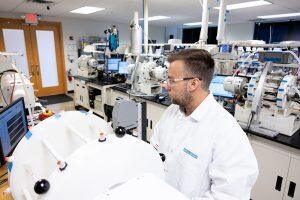Durability and Fatigue Testing
Medical Device Testing Services
 Fatigue and durability have been an engineering challenge because the human body is one of the most challenging environments in which to implant a device. Fatigue and durability testing may be needed during your product development process to assess the ability of your device to withstand these challenges. Durability testing may include pulsatile, flat plate, low- and high-cycle longitudinal, bending, axial, torsional, and custom-designed loading modes. The actual tests will depend on clinical boundary conditions, such as movement, strain, and force that are present when the device is implanted in the body. Our mastery of physical bench testing and iterative alignment of this testing with clinical performance are key elements provided as part of our services. We can couple the bench and clinical experience with finite element analysis (FEA) capabilities to deliver a complete durability evaluation package for risk mitigation.
Fatigue and durability have been an engineering challenge because the human body is one of the most challenging environments in which to implant a device. Fatigue and durability testing may be needed during your product development process to assess the ability of your device to withstand these challenges. Durability testing may include pulsatile, flat plate, low- and high-cycle longitudinal, bending, axial, torsional, and custom-designed loading modes. The actual tests will depend on clinical boundary conditions, such as movement, strain, and force that are present when the device is implanted in the body. Our mastery of physical bench testing and iterative alignment of this testing with clinical performance are key elements provided as part of our services. We can couple the bench and clinical experience with finite element analysis (FEA) capabilities to deliver a complete durability evaluation package for risk mitigation.
Our first fatigue test of a medical device was in 1999. Since that time we have completed a trillion plus cycles of durability testing on medical devices (1,000,000,000,000). This experience is significant and available. Some of the questions we encounter are as follows:
- What are the appropriate physiological boundary conditions for my device?
- How many samples do I need to evaluate to adequately reduce the risk of failure?
- How fast can I run this fatigue test to equate to 10 years of use?
- What type of test do I run (a test to success or a fatigue to failure (ftf) test)?
- What is constant life testing?
- How do I evaluate a success and what do I do at the end of a fatigue test?
Our Methods
Our lab is ISO/IEC 17025:2017 accredited for fatigue and durability testing. We perform almost every type of boundary condition development activity needed for your device, and have experience with fatigue and durability evaluations in accordance with ASTM and ISO standards.
PUBLICATIONS
D. Choules, A. L. Lewis, B. G. Gulker, J. M. Metcalf, & J. D. Kelley (2019). Effect of Variable Amplitude Loading in Nitinol Fatigue. In M. Mitchell, B. Berg, T. Woods, & K. Jerina (Eds.), STP1616-EB Fourth Symposium on Fatigue and Fracture of Metallic Medical Materials and Devices(pp. 54-68).
TEST METHODS
- ASTM F2477
- ASTM F2942
- ASTM F3036
- ASTM E739
- ISO 25539 – 1, 2, 3
- Lab developed medical device testing method FATG-320
- Lab developed medical device testing method FATG-401
- Lab developed medical device testing method FATG-500
- Lab developed medical device testing method FATG-700
- Lab developed medical device testing method FATG-800
- Lab developed medical device testing method FATG-900
OUR COMMITTMENT
We are committed to consistently performing services with high quality, that deliver exceptional results, and add value to the client’s business.
For client surveys sent in the last two quarters, we received ratings of 4.76/5 points (10).
